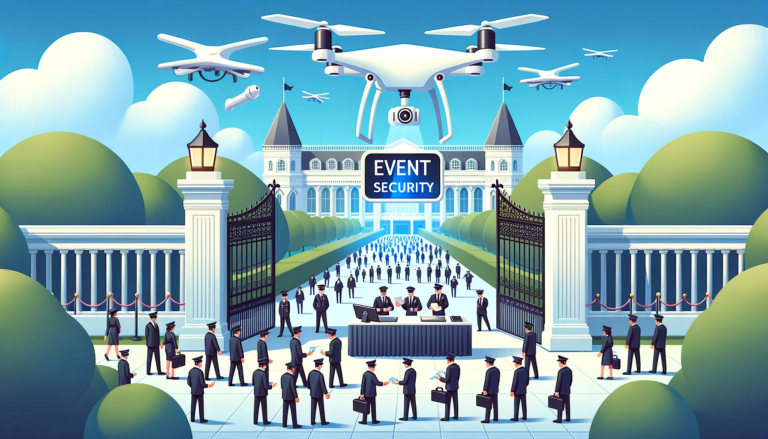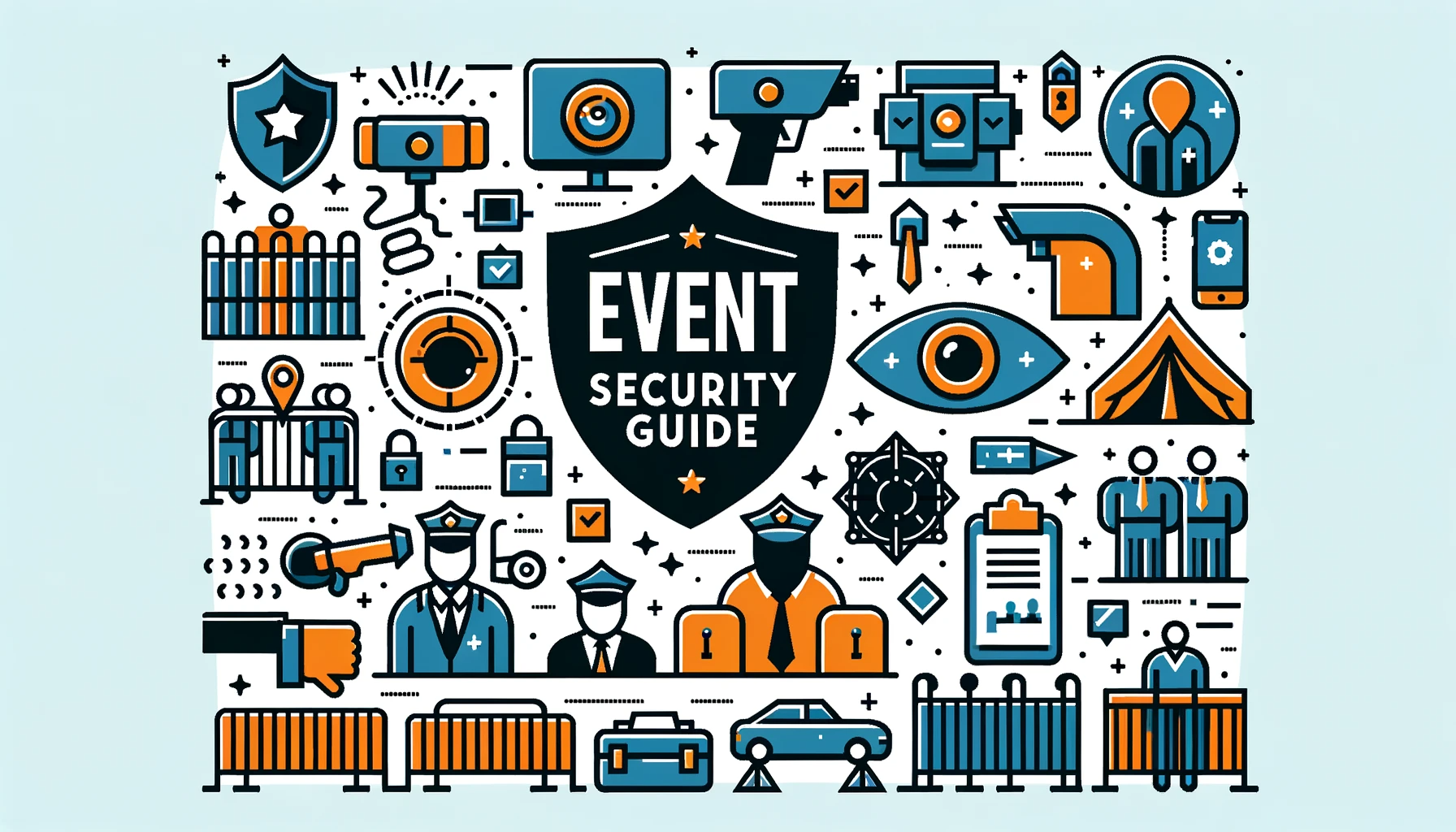In today’s fast-paced world, large-scale events, whether they be cultural festivals, sports events, or political rallies, play a pivotal role in bringing communities together. With the sheer number of attendees, ensuring the security of these events is paramount. The term “Event Security” is not just about hiring a few guards; it encompasses a holistic approach that considers multiple facets of safety. When we talk about event security, we’re diving deep into intricate planning, state-of-the-art technology, and seamless collaboration between various stakeholders.
You might wonder, why is there such an emphasis on event security. The simple answer is that the safety of attendees, staff, and even the reputation of the event organizers is at stake. Any security mishap can lead to catastrophic consequences, both in terms of human lives and financial losses. Thus, mastering the art and science of event security is essential for anyone involved in organizing or managing large-scale events in the U.S.
1. The Significance of Security at Large-Scale Events
Fact: Studies have shown that attendees’ perception of safety can directly influence their overall event experience and likelihood to attend future events.
When we think about large-scale events, excitement, and entertainment come to mind. However, behind the scenes, a significant amount of effort goes into ensuring that these events are not just enjoyable but safe. Security at such events is not merely a logistical requirement; it’s a matter of public trust. Attendees trust organizers to provide a safe environment, and any breach of this trust can lead to significant reputational damage.
Consider the case of a music festival. With thousands of attendees, multiple entry and exit points, and various activities happening simultaneously, the potential risks are immense. From minor incidents like pickpocketing to major concerns like stampedes or terrorist threats, the spectrum of security challenges is vast. Therefore, understanding the significance of security measures becomes the foundation of successful event management.
Incorporating robust security measures not only ensures the safety of attendees but also enhances the overall event experience. When attendees feel safe, they can immerse themselves in the event without any reservations. Moreover, a well-secured event can lead to positive word-of-mouth publicity, encouraging more people to participate in future events.
2. Risk Assessment and its Role in Event Security
Fact: A comprehensive risk assessment can help in identifying over 90% of potential security threats, enabling organizers to take proactive measures.
Before diving into the actual security measures, it’s crucial to understand what we’re up against. This is where risk assessment comes into play. By systematically evaluating potential threats and vulnerabilities associated with an event, organizers can prioritize their security efforts.
Risk assessment starts with gathering data. What is the nature of the event? How many attendees are expected? What’s the venue layout? Are there any past incidents associated with similar events? By answering these questions, organizers can paint a clearer picture of the security landscape.
Once the data is collected, the next step involves identifying potential threats. These could range from external threats like terrorism or protests to internal threats like overcrowding or mismanagement. Each threat is then evaluated based on its likelihood and potential impact.
After identifying and evaluating threats, the final step is mitigation. This involves devising strategies to either eliminate these threats or reduce their impact. For instance, if there’s a risk of overcrowding at a particular entry point, organizers can either increase the number of entry points or deploy additional security personnel to manage the crowd.
3. Security Personnel: Hiring, Training, and Deployment
Fact: A well-trained security team can deter over 80% of potential threats simply by their presence and proactive approach.
Security personnel are the backbone of any event security strategy. Their presence, actions, and decisions can make the difference between a secure event and a disaster. Hence, it’s imperative to ensure that the security team is not just abundant in number but also competent in their roles.
Hiring the right security personnel starts with a thorough vetting process. It’s not just about physical fitness; it’s equally important to assess their mental agility, decision-making skills, and past experience. Once the right team is in place, rigorous training becomes the next critical step. This training should encompass both theoretical knowledge about potential threats and practical drills simulating various security scenarios.
Deployment is equally crucial. Based on the risk assessment, security personnel should be strategically placed at various points of the venue. For instance, high-risk areas like entry and exit points might require more guards, while other areas might benefit from undercover security personnel mingling with the crowd.
Remember, the key is to strike a balance. While it’s essential to ensure safety, it’s equally vital that attendees don’t feel overwhelmed by the security presence. After all, the primary goal of any event is to provide an enjoyable experience, and an overtly strict security environment might dampen the spirit.
4. Technological Innovations in Event Security
Fact: Modern technology can enhance the efficiency of security measures by up to 60%, especially when it comes to surveillance and threat detection.
In this digital age, relying solely on human efforts for event security is no longer feasible. Technological advancements have provided us with tools that can significantly bolster our security strategies. From surveillance cameras with facial recognition capabilities to drones monitoring overhead, technology plays a pivotal role in modern event security.
One of the primary benefits of incorporating technology is the ability to monitor large areas in real time. For instance, a drone can provide an aerial view of the entire event, helping security teams identify potential crowd surges or other disturbances. Similarly, surveillance cameras equipped with facial recognition can quickly identify and flag individuals with a dubious past or those on watch lists.
Beyond surveillance, technology also aids in communication. Advanced communication tools ensure that security teams can quickly relay information, ensuring a swift response to any potential threats.
However, with great power comes great responsibility. While technology offers numerous benefits, it’s essential to use it ethically. Issues like privacy concerns and data security should always be at the forefront when incorporating technological solutions.
5. Access Control and Crowd Management Techniques
Fact: Proper access control can reduce unauthorized entries by up to 95%, ensuring that only legitimate attendees gain access to the event.
Access control is the first line of defense in event security. It’s the process of ensuring that only authorized individuals can enter the event venue. This not only helps in preventing potential threats but also plays a significant role in crowd management.
The first step in access control is ticketing. Tickets with unique barcodes or QR codes can quickly be scanned, ensuring that only those who’ve purchased a ticket can enter. For more high-profile events, RFID wristbands can offer an added layer of security.
Once inside, crowd management becomes crucial. The goal here is to ensure that attendees can move freely without causing bottlenecks or overcrowding. Clear signage, designated pathways, and barriers can help in guiding the crowd. Additionally, security personnel should be trained to identify and manage potential crowd surges, ensuring that attendees have a safe and enjoyable experience.

6. Emergency Response and Evacuation Planning
Fact: A well-executed evacuation plan can reduce the time taken to clear a venue by up to 70%, potentially saving countless lives in case of emergencies.
No matter how well we plan, emergencies can arise. Whether it’s a natural calamity like a fire or an external threat like a terror attack, having a robust emergency response and evacuation plan is non-negotiable.
Such a plan should detail the roles and responsibilities of each security personnel, the communication channels to be used, and the evacuation routes. Regular drills should be conducted to ensure that the plan can be executed smoothly in case of an actual emergency.
Remember, in times of crisis, panic is the biggest adversary. A well-communicated and practiced evacuation plan can help in maintaining calm, ensuring that attendees can safely exit the venue.
7. Communication Systems for Seamless Security Operations
Fact: Efficient communication can increase the response rate of security personnel by up to 50%, enabling them to address threats or issues promptly.
Seamless communication is the lifeline of effective event security. It ensures that every member of the security team, from the ground personnel to the control room, is on the same page, facilitating swift responses to any emerging situations.
Modern communication systems have moved beyond the traditional walkie-talkies. Digital radios, encrypted communication channels, and real-time data-sharing platforms have revolutionized the way security teams communicate. These tools ensure that information is relayed without distortion, allowing for accurate and timely decisions.
For instance, if a security personnel identifies a potential threat at one of the entry points, they should be able to instantly communicate this to the control room. The control room can then relay this information to other security checkpoints, ensuring a coordinated response.
Moreover, backups for these communication systems are crucial. In the event of a system failure, there should be an alternative means of communication to ensure continuity in operations.
8. Collaboration with Local Law Enforcement
Fact: Collaborating with local law enforcement can enhance the security quotient of an event by 80%, thanks to the added expertise and resources they bring.
Local law enforcement agencies possess a wealth of knowledge about the region, and potential threats, and have resources that can immensely benefit event security. Establishing a strong collaboration with these agencies can be a game-changer.
Before the event, organizers should liaise with local police, fire departments, and emergency medical services. Sharing the event’s layout, expected footfall and potential risk areas can help these agencies prepare better. They can provide insights, additional manpower, or even specialized equipment that can further bolster security.
During the event, having law enforcement officers present can act as a deterrent for potential miscreants. Their expertise can also be invaluable in managing crowd control, and traffic, and addressing any emergencies that might arise.
9. Transportation and Parking Security Measures
Fact: Secure transportation and parking can reduce vehicle-related incidents by up to 90%, ensuring attendees’ safety even before they enter the event venue.
The security of an event doesn’t start at the entry gates; it begins much earlier. Secure transportation and parking are often overlooked aspects of event security, but they are crucial. After all, before attendees can enjoy the event, they need to safely reach the venue and park their vehicles.
Organizers should ensure that parking areas are well-lit, monitored by security cameras, and patrolled by security personnel. Clear signage indicating parking zones, emergency exits, and pathways can prevent chaos and congestion.
For events providing shuttle services, the vehicles should be checked for safety, and drivers should be vetted. Ensuring that pick-up and drop-off points are secure and efficiently managed can enhance the overall event experience for attendees.
10. Post-Event Security Evaluation and Feedback Mechanisms
Fact: Regular post-event evaluations can lead to a 60% improvement in security measures over time, as organizers can learn from past experiences.
Once the event concludes, the job isn’t over. A thorough post-event evaluation is essential to understand what went right and where there’s room for improvement. This involves gathering feedback from security personnel, attendees, and collaborating agencies.
Feedback mechanisms, like surveys or feedback booths, can provide insights from attendees. Were they satisfied with the security measures? Did they face any issues? Such feedback is invaluable.
Similarly, security personnel can highlight challenges they face, areas of congestion, or potential vulnerabilities. Collaborating agencies can provide a third-party perspective, offering insights that internal teams might overlook.
By regularly evaluating and iterating on the security measures, organizers can ensure that every subsequent event is safer than the last.
Event security is not just a logistical challenge; it’s a commitment to the safety and well-being of every single individual present. In the world of large-scale events, where the stakes are high and margins for error are slim, understanding and implementing robust security measures is not just a necessity; it’s a responsibility.
The phrase “Event Security” encapsulates so much more than patrolling guards and metal detectors. It’s about a comprehensive, multi-faceted approach that combines human expertise with technological advancements, proactive planning with reactive capabilities, and individual vigilance with collective responsibility. It’s about ensuring that every attendee, from the excited fan in the front row to the dedicated staff working behind the scenes, can trust in the environment around them.
As we’ve delved deep into this topic, one thing has become abundantly clear: security is an ever-evolving challenge. What worked yesterday might not be sufficient tomorrow. Hence, constant learning, evaluation, and adaptation are paramount. Collaborating with experts, leveraging the latest technology, and most importantly, listening to feedback are the keystones of an effective security strategy.
To all event organizers and security personnel reading this, remember that your efforts play a pivotal role in creating memorable experiences. Every time an attendee reminisces about an event, cherishing the moments of joy, music, and camaraderie, they do so knowing they were in a safe environment, and that’s largely thanks to you. So, as we wrap up this comprehensive guide on event security, let’s reiterate our commitment to safety, diligence, and continuous improvement. After all, in the grand spectacle of large-scale events, security isn’t just a feature; it’s the foundation.
We welcome any suggestions or questions. You can email us or contact us using the contact page.
You can also connect with us on the following social networks:






0 Comments